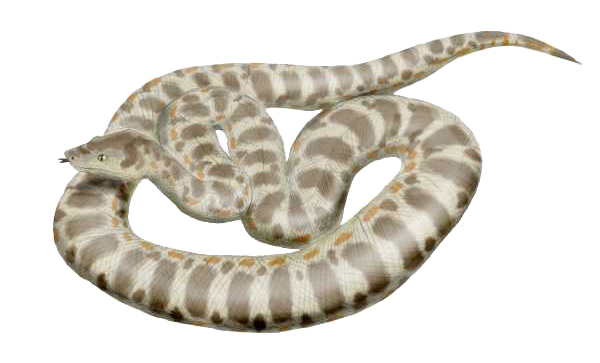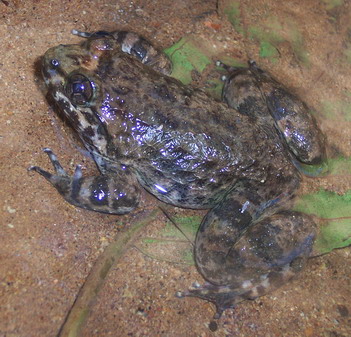Please see Part I of this article for the exciting story behind the “re-discovery” of Australia’s Gold-Spotted Bell Frog (Litoria castanea), which was assumed by herpetologists to have been extinct since the 1970’s. Today I’d like to discuss my experiences breeding a close relative that sometimes appears in the pet trade, the Green and Gold Bell Frog (Litoria aurea). Read More »
Category Archives: Recent Research
Feed SubscriptionAmazing Fossil Confirms that Ancient Snakes Consumed Dinosaurs
 Herp enthusiasts grow up hearing such things as “Reptiles and amphibians are older than the dinosaurs…”, but it is hard to imagine what this means – to actually picture creatures that look like modern-day turtles or frogs interacting with dinosaurs. Well, interact they did – a fossil unearthed in Western India depicts a snake about to consume a young dinosaur. Read More »
Herp enthusiasts grow up hearing such things as “Reptiles and amphibians are older than the dinosaurs…”, but it is hard to imagine what this means – to actually picture creatures that look like modern-day turtles or frogs interacting with dinosaurs. Well, interact they did – a fossil unearthed in Western India depicts a snake about to consume a young dinosaur. Read More »
First Completely Monogamous Amphibian Identified – the Mimic Poison Frog
 Genetic research has revealed that a fairly well-studied frog has been hiding an astonishing secret – pairs form lifelong pair bonds and remain faithful to one another. Equally surprising is the fact that pool size alone (and not morality!) seems responsible for the fidelity shown by Mimic Poison Frog (Ranitomeya imitator) couples. These findings, to be published in an upcoming issue of The American Naturalist, illustrate the second “first” for this species (please see below). Read More »
Genetic research has revealed that a fairly well-studied frog has been hiding an astonishing secret – pairs form lifelong pair bonds and remain faithful to one another. Equally surprising is the fact that pool size alone (and not morality!) seems responsible for the fidelity shown by Mimic Poison Frog (Ranitomeya imitator) couples. These findings, to be published in an upcoming issue of The American Naturalist, illustrate the second “first” for this species (please see below). Read More »
Research News – After Feeding, Snakes Remodel their Gut and Produce New Cells
Like most reptile keepers, I have often marveled at the efficiency of snake digestive systems. I attributed their abilities to break down bone to “powerful digestive enzymes”, but recent research has shown that, at least for Burmese Pythons (Python molurus), a far more complex and amazing process is at work.
Digesting Large Vertebrates
 I’ve observed some quite large snake feasts – a Red Foot Tortoise and a 60 pound deer taken by Green Anacondas (the tortoise was an unfortunate exhibit mate; the deer fell to an anaconda at my study site in Venezuela) and 40 pound pigs regularly fed to Reticulated and Burmese Pythons under my care at the Bronx Zoo, for example.
I’ve observed some quite large snake feasts – a Red Foot Tortoise and a 60 pound deer taken by Green Anacondas (the tortoise was an unfortunate exhibit mate; the deer fell to an anaconda at my study site in Venezuela) and 40 pound pigs regularly fed to Reticulated and Burmese Pythons under my care at the Bronx Zoo, for example.
A few shell scutes, hoofs, some bone fragments and fur where all that passed in the feces of these snakes – the rest being digested. How do they do it?
Bone-Digesting Cells
Research at the Louis Pasteur and Indiana Universities has revealed that, after feeding, the digestive systems of Burmese Pythons undergo a dramatic transformation. New cells are produced and worn-out cells die and are eliminated in preparation for the work at hand.
Studies of the small intestine have uncovered a new type of cell, previously unknown to science. These cells are responsible for degrading bone and releasing its components into the snake’s bloodstream. This process promotes efficient calcium absorption, and may be the reason that most captive snakes do not require a UVB source if fed a diet comprised of whole rats, mice and other vertebrates.
Warm-Blooded Snakes? Not Quite, but…
We’ve known for some time now that Burmese Pythons break the “cold-blooded” rule when digesting their meals. While most snakes must seek out a hot basking spot in order to maximize digestion, Burmese Pythons can actually raise their internal temperatures without an external heat source!
Further Reading
Please see Big Snake Meals for some examples of how large (and unusual) snake prey can be.
To read about recent research concerning another unusual snake feeding adaptation, please see How Snakes Grow despite Food Deprivation.
An account of the original research showing that pythons can raise their body temperatures may be found in this Journal of Herpetology article.
A Bird-Eating Frog is Discovered in Thailand – Research Update
In 1705, a painting of a Pink-toed Tarantula consuming a hummingbird, published in Maria S. Merian’s book on the insects of Suriname, aroused so much attention (and horror!) that all New World tarantulas are commonly termed “bird-eating spiders” to this day. It seems now that amphibian fanciers have their own dramatic bird-eater – Limnonectes megastomias, an aquatic frog recently described from 3 locations in Thailand.
An Aquatic Ambush Predator
 The newly discovered frog is largely aquatic, and apparently catches birds that come to the water’s edge to drink – quite a unique feeding strategy for a frog (I once saw a surprising film of African Side-necked Turtles catching doves in this manner).
The newly discovered frog is largely aquatic, and apparently catches birds that come to the water’s edge to drink – quite a unique feeding strategy for a frog (I once saw a surprising film of African Side-necked Turtles catching doves in this manner).
It is assisted in hunting by large (to 2 inch) “fangs” and a head that is disproportionately large for the body. The fangs are not true teeth but rather extensions of the jawbone, known as odontoid processes. The African Bullfrog and the South American Horned Frogs, known also for consuming vertebrates (and biting the hand that feeds them!), also sport odontoid processes. Insects and other frogs have also been recorded as prey.
Same Bodies, Larger Heads – Sexual Dimorphism
Interestingly, the heads and “teeth” of male Bird-eating Frogs grow much larger than those of females, despite similar body sizes. In certain other creatures (i.e. Barbour’s Map Turtles) this strategy allows the sexes to consume different diets and, it is theorized, avoid competition. Researchers also believe that the enlarged teeth are used in combat, as many males carry scars.
So Much to Discover
There are over 50 species classified in the genus Limnonectes- the new “bird-eater” appears most closely related to the Kuhl’s or Large-Headed Frog, L. Kuhlii, but little is known of its natural history (the photo attached is of a Kuhl’s frog).
This new species was first observed at the Sakaerat Environmental Research Station, an area that has been extensively studied for 40 years. The fact that such a large and unique frog was able to remain undiscovered in this area illustrates the untold opportunities open to those who wish to get out and look around in just about any habitat – recently a new centipede was discovered in NYC’s Central Park!
Further Reading
Another toothed amphibian behemoth, the African Bullfrog, also takes quite large prey…to read about a most unusual frog meal, please see my article An Appetite for Cobras.
Limnonectes kuhlii image referenced from wikipedia and originally posted by W. Djatmiko
 That Reptile Blog – Reptile, Amphibian and Exotic Pet Care and Information
That Reptile Blog – Reptile, Amphibian and Exotic Pet Care and Information
